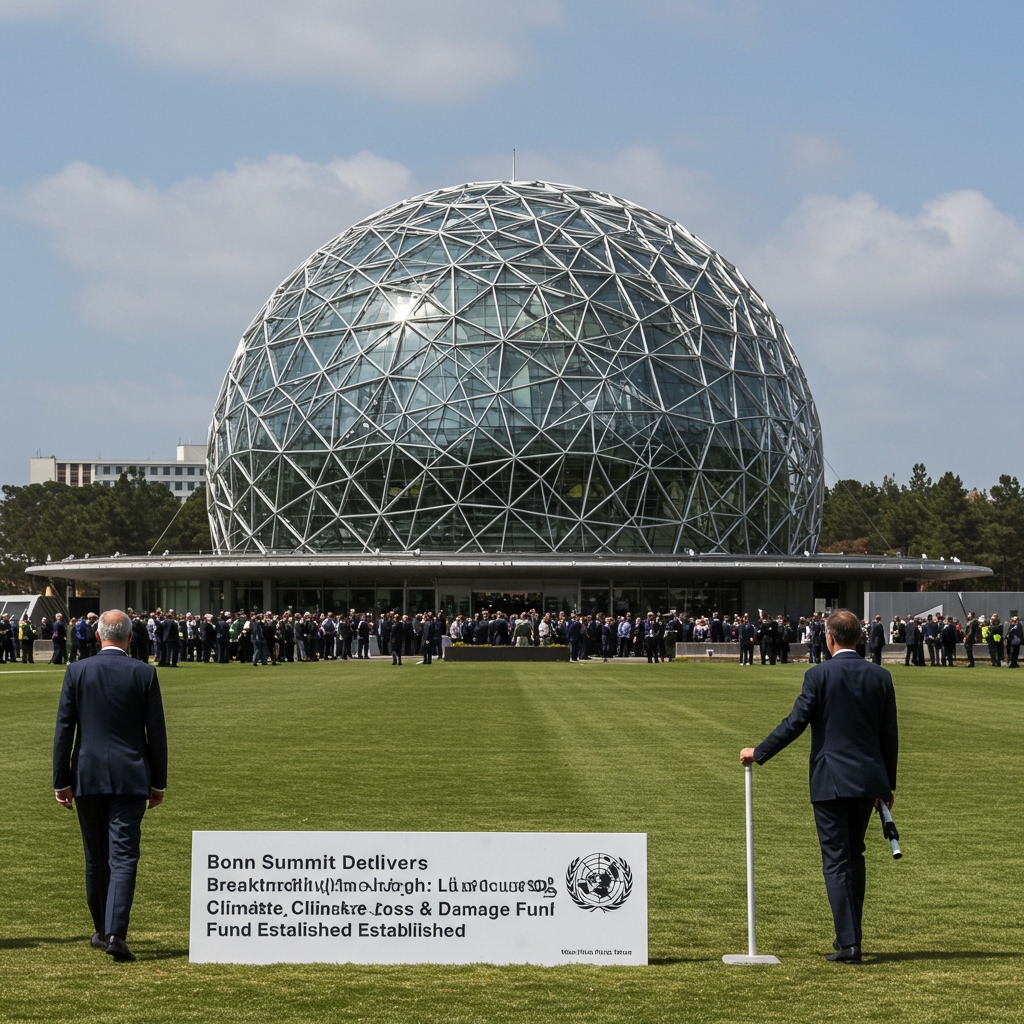Historic Agreement Forged at Bonn Climate Talks
BONN, GERMANY – After intense negotiations spanning nearly two weeks, representatives from 195 countries successfully concluded the latest session of the UN Climate Change Conference here on January 27, 2025. The summit culminated in a landmark agreement establishing a dedicated “Loss and Damage Fund” aimed at providing crucial financial and technical assistance to nations most vulnerable to the devastating impacts of climate change.
This development is being hailed as a significant breakthrough, addressing a long-standing demand from developing countries who argue they bear a disproportionate burden of the effects of climate change, despite contributing minimally to the historical emissions causing it. The agreement acknowledges the irreversible losses and damages – ranging from extreme weather events like floods and droughts to slower-onset impacts such as sea-level rise and desertification – that are already occurring and are projected to worsen.
The Loss and Damage Fund: A New Era of Climate Finance
The core outcome of the Bonn summit is the formal establishment and operationalization framework for the Loss and Damage Fund. While the concept has been discussed for years within the UNFCCC framework, previous conferences struggled to reach consensus on its structure, funding sources, and eligibility criteria. The agreement reached in Bonn represents the political will necessary to move from concept to concrete action.
The fund is designed to support developing countries that are particularly susceptible to the adverse effects of climate change, helping them to cope with impacts that go beyond what they can adapt to. This includes providing financial aid for reconstruction after climate-related disasters, supporting planned relocation from areas becoming uninhabitable, and addressing non-economic losses such as cultural heritage sites destroyed by rising sea levels or loss of biodiversity.
Delegates worked tirelessly to define the fund’s governance structure, which is intended to be equitable and responsive to the needs of recipient countries. While specific operational modalities will continue to be refined, the agreement lays the essential groundwork for the fund to become functional and disburse resources.
Financial Commitments and Future Outlook
A critical element of the Bonn agreement is the financial commitment secured from developed nations. Following extensive and often difficult diplomatic efforts, developed countries pledged an initial combined contribution exceeding $50 billion towards the newly established Loss and Damage Fund. This initial capitalization is seen as a vital starting point, signaling a tangible commitment from historically larger emitters.
The agreement also includes mechanisms for replenishing the fund, outlining processes that will guide contributions through 2030. This forward-looking approach is intended to ensure the fund’s long-term viability and its capacity to meet the escalating needs of vulnerable nations as climate impacts intensify. Discussions are expected to continue on diversifying funding sources in the future, potentially involving international financial institutions, innovative sources of finance, and contributions from emerging economies, although the initial onus rests primarily on developed nations as per the principle of common but differentiated responsibilities.
Securing this level of initial funding was a key negotiating point and is viewed as a necessary first step, although many advocates and studies suggest that the overall financial needs for addressing global loss and damage run into hundreds of billions, if not trillions, of dollars annually. Nevertheless, the $50 billion-plus figure represents a significant initial mobilization of resources previously unavailable for this specific purpose under the UNFCCC.
Broader Support for Climate Resilience
Beyond the cornerstone Loss and Damage Fund, the Bonn agreement also incorporated crucial provisions aimed at bolstering the overall climate resilience of developing economies. Recognizing that adaptation efforts are paramount, but not always sufficient, the summit included enhanced commitments for technology transfer and capacity building.
Technology transfer provisions are designed to facilitate access to and deployment of climate-resilient technologies in developing countries. This ranges from early warning systems for extreme weather to sustainable infrastructure materials, drought-resistant crops, and renewable energy technologies. The goal is to accelerate the adoption of innovations that can help these nations adapt to changing climate conditions and reduce their vulnerability.
Capacity building measures outlined in the agreement focus on strengthening the institutional and human capacities within developing countries to effectively plan, implement, and manage climate action. This includes training local experts, developing national climate strategies, improving data collection and analysis for risk assessment, and enhancing access to climate finance. These provisions are intended to ensure that vulnerable nations are not only recipients of aid but are also empowered to lead their own climate adaptation and resilience-building efforts.
The Culmination of Intense Diplomatic Efforts
The success of the Bonn summit in reaching this comprehensive agreement is the direct result of intense diplomatic efforts over the past year. The issue of loss and damage finance had gained significant momentum in recent years, becoming a central focus of climate negotiations. COP27 saw a breakthrough commitment in principle to establish a fund, which was then followed by dedicated transitional committee meetings tasked with hammering out the operational details.
These year-long intersessional negotiations were marked by complex discussions on funding sources, governance, relationship with existing financial mechanisms, and the definition of eligibility. Bridging the diverse perspectives and priorities of developed and developing countries required persistent dialogue, compromise, and a shared recognition of the urgency of the climate crisis and its irreversible impacts on the most vulnerable populations.
The agreement reached in Bonn is therefore not just a technical outcome but a political achievement, demonstrating renewed multilateral cooperation on a critical and historically contentious issue in climate diplomacy. It sets a precedent for how the international community can mobilize resources to address the unavoidable consequences of climate change.
Looking Ahead
While the establishment of the Loss and Damage Fund and the associated financial pledges are cause for cautious optimism, the path forward involves significant challenges. The operationalization of the fund, the disbursement of resources, and the continuous replenishment mechanisms will require sustained political will and cooperation.
However, the January 27, 2025, agreement reached at the Bonn summit is widely regarded as a critical step. It provides a dedicated financial mechanism to address the most severe impacts of climate change, complements ongoing efforts in mitigation and adaptation, and underscores the principle of climate justice by prioritizing support for those least responsible for, yet most affected by, the warming planet. The focus now shifts to implementation and ensuring the fund effectively serves the vulnerable communities it is intended to protect.





